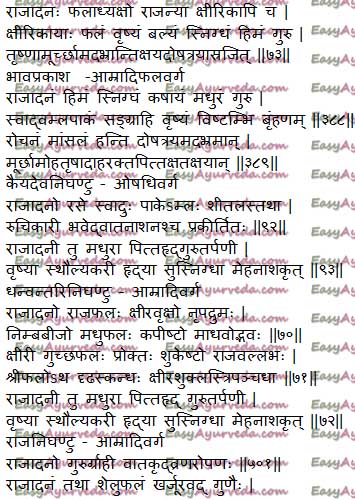Khirni (Manilkara hexandra) – Qualities, Uses, Remedies, Research
By Dr Renita D’Souza
Khirni (Manilkara hexandra) is a curative Ayurvedic medicinal tree used in the treatment of excess thirst, emaciation, bleeding disorders, ulcer, bronchitis, jaundice, fever, arthritis etc. It improves taste, promotes physical strength and aphrodisiac in nature.
Table of Contents
Introduction
Fresh fruits contain proteins, lipids, carbohydrates and moisture. Fruits are rich source of vitamin A and recommended to those who wish to gain weight.
Botanical Name – Manilkara hexandra
Synonyms – Mimusops hexandra
Family – Sapotaceae
Names in different languages
English Name – Ceylon Iron Wood, Milk tree, Wedge-leaved ape flower
Hindi Name – Khirni, khini, khinni, drirh, Kshiri, Rayan
Bengali Name – Khir Khejoor, krikhiyur
Marathi Name – Khirni, karani, Rajana, Ranjana, Rayan, Rayani
Gujarati Name – Rayan kaakdiha, khirni,
Kannada Name – Khirni mara
Tamil Name – Palla, Palai, ulakkai-p-palai
Telugu Name – Paalmanu, ankalu, nandivriqshamu, palachettu
Konkanni Name – Karni, Ranjana
Malayalam Name – krini, pazhamunpaala
Medicinal Qualities of Khirni
Taste – Astringent (kashaya), Sweet (madhura)
Virya (potency) – cold (hima)
Vipaka (taste after digestion) – Sweet, Sour
Vrshya – aphrodisiac
Balya – promotes physical strength
Snigdha – unctuous
Guru – heavy to digest
Hrdya – cardiac tonic
Sanghrahi – absorbent in nature
Vishtambhi – constipating
Bhrhmana – nourishing
Rochana – improves taste
Mamsala – increases muscle bulk
Sthoulya kaari – increases weight, causes obesity.
Morphology
Manilkara hexandra is a slow growing evergreen tree. Leaves 3 – 6 cm long, simple, alternate, elliptic-obovate and glabrous. Flowers small, white or pale yellow in colour. Fruits a berry, oblong to ellipsoid, reddish-yellow and one seeded.

Traditional Uses
Trshna – excess thirst
Murcha – fainting
Mada – alcohol intoxication
Bhranti – dizziness, psychosis
Kshaya – emaciation, tuberculosis
Blood disorders
Daha – burning sensation
Raktapitta – bleeding disorders
Vrana ropana – heals wound
Bark oil is nutritive (balya) and unctuous in nature. Bark is used medicinally as similar to Bakula bark.
Read – Bakula – Mimusops elengi: Benefits, Remedies, Research, Side Effects
Part Used
Bark, Bark oil, Seed oil, Fruits, Leaves
Traditional Remedies of Kirni
- Stem bark decoction is used as effective remedy in dysentery and diarrhoea.
- Mashed fruits are used as remedy to treat arthritis, jaundice, heat burning and wormicide. It purifies blood.
- Leaf extract is used in the treatment of asthma.
- In toothache, latex of the tree is applied on teeth and gums.
- Root extract is used in treatment of headache.
- To relieve body ache, water boiled with stem bark is used for bathing.
- Extract of stem bark is used as tonic.
- Stem bark infusion is used to promote and increase breast milk.
- Decoction of bark and mashed fruits is used in fever and hallucinations
Interaction with medicines, supplements
Can this be used while taking Homeopathic medicine?
Yes. This product does not react with homeopathic medicine.
Can
this medicine be continued while taking supplements like multivitamin tablets,
Omega 3 fatty acids etc?
Yes. Generally, this product goes well with most
of the dietary supplements. However, if you are taking more than one product
per day, please consult your doctor for an opinion.
With western
medicines
Seek your
doctor’s advice if you are taking this product along with other western
(allopathic / modern) medicines. Some Ayurvedic herbs can interact with modern
medicine.
If both Ayurvedic and allopathic medicines are advised together, then it is
best to take Allopathic medicine first, wait for 30 minutes and then take the
Ayurvedic medicine.
Pharmacology, chemical composition
Pharmacological Activities
Anti–inflammatory, anti-ulcer, aphrodisiac, alexipharmic, anthelmintic, antibacterial, and free radical scavenging activity
Chemical constituents
Manilkara hexandra contains phytoconstituents such as sterols, tannin, saponins, unsaponifialble lipids, triterpene alcohols, terpenoids and phenolic compounds such as gallic acid, myrecetin, and quercetin etc
Distribution
Manilkara hexandra is found in Sri Lanka, India and Indo-China.
Sanskrit synonyms
Phaladhyaksha, Raajanya,
Kshirika – secrete milky latex
Drdaphala, Malaashi,
Kshathriya, Priyadarshana
Rajaavah, Kshirophalokshi, Guchaphala
Vaanarapriya, Kapiesta – fruits liked by monkeys
Shukesta – fruits liked by parrots
Madhuphala, Nimba beeja
Research
1. A review article describes traditional uses, phytochemistry and pharmacology of Mimusops hexandra Roxb. (read here)
Classical categorisation
Bhavaprakasha Nighantu – Amraadiphala Varga
Kaiyadeva Nighantu – Aushadi Varga
Dhanvantari Nighantu – Amraadi Varga
Raja Nighantu – Amraadi Varga
Shodala Nighantu – Amraadi Varga
Click to Consult Dr Renita D’Souza










One comment
saroj
thankyou